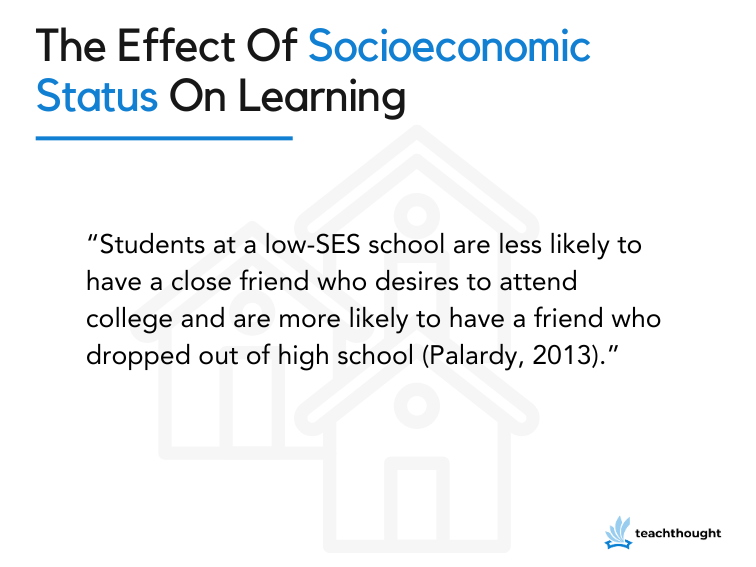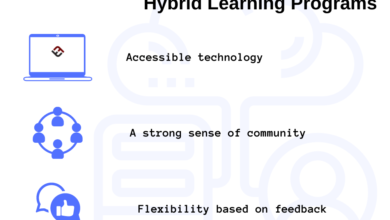
contributed by Michael Mirra
Abstract
Diversity has been at the forefront of educational discussions over the last few years. When we think about having a diverse classroom we think of ethnicity, race, gender, nationality, religion, and sexual orientation. It is easy for us to forget about socioeconomic status. This paper explores the impact socioeconomic status has on student learning in order for teachers to have a better understanding of their diverse classroom.
Keywords: socioeconomic status, informer choice, late-emerging reading development, standardized testings, student attainment, service-learning
How Socioeconomic Status Influences Learning
At the beginning of the school year, teachers are made aware of characteristics of their students in order to create accommodations. One aspect that is less commonly brought up is socioeconomic status (SES). When a teacher looks at their classroom, they do not see or necessarily know the varying levels of SES that are in front of them. SES has an impact on learning and teachers need to be aware of these impacts if they are going to teach all students.
Corriveau and Kurkul (2016) administered a study of preschool-aged students about how they choose from whom to learn. The purpose of the study was to see if a preschoolers’ preference in informer is related to SES (Corriveau & Kurkul, 2016). Background research on children’s learning showed that preschoolers have two qualifiers when choosing an informer.
They prefer either someone they previously deemed accurate or someone who shares their cultural background (Corriveau & Kurkul, 2016). The authors expand on the first qualifier of accuracy with preference in voice. They ask if there is a preference between a passive voice and an active voice. Passive voice is used in academic language and may be viewed as more accurate than active voice (Corriveau & Kurkul, 2016). They then look to see if preference in voice is related to SES.

Research: The Influence Of Socioeconomic Status On Learning
Their study included 32 children between the ages of four and five from the same preschool. Low-SES was defined as being eligible for free or reduced lunch (Corriveau & Kurkul, 2016). Two informers were presented over several video clips. One informer used a passive voice and the other an active voice. The videos included vocabulary, picture description, and labeling tasks (Corriveau & Kurkul, 2016).
Preference in informer was determined by each child’s judgment of which one was ‘better.’ The results showed that 57% of high-SES students preferred the passive voice where only 25% of low-SES students did (Corriveau & Kurkul, 2016, p. 1533). Low-SES students preferred the active voice.
The researchers hypothesize that this is a result of exposure stating that “children from higher SES families experience more literacy activities” and “exposure to books might be one mechanism by which children associate passive syntax with competence” (Corriveau & Kurkul, 2016, p. 1535). It is concluded that the experience that comes from SES influences preference in the informer.
SES impacts learning right from the beginning. We may think that everyone starts off on the same foot in preschool, but that is not the case. The process of how students learn is shaped before they begin and can set them on a different path than their peers. We need to be aware of how they are learning to help them become the most successful they can be.
Research: The Influence Of Socioeconomic Status In Elementary School
Kieffer (2010) organized a study on upper elementary students focusing on reading levels of English language learners (ELLs) and native English speakers. The purpose of the study was to look at late-emerging reading difficulties among both groups while taking SES into account. There has been a growing concern about students who successfully learn to read in the lower elementary grades and then fall behind in the upper elementary grades. ELLs and low-SES students are at an elevated risk for these difficulties (Kieffer, 2010). Kieffer looks at both groups to see how SES impacts late-emerignig reading difficulties.
For his study, ELLs included students whose schools designated them as ‘limited English proficient’ and later gained enough English proficiency to lose that designation. Longitudinal data was collected from a nationally represented sample across three periods: third grade, fifth grade, and eighth grade (Kieffer, 2010). ELLs were shown to be at a greater risk of reading difficulties than native English speakers at each period.
Additionally, low-SES students were seen to be at a greater risk than high-SES students at each period. When the data is looked at with SES, the difference in risk between ELLs and native English speakers is reduced significantly (Kieffer, 2010). The researcher concluded that ELLs and native English speakers with low-SES are not different in their risk for late-emerging reading difficulties. He added, “Given that most ELLs in the sample also had low-SES, this suggests that SES, rather than ELL status, is the most predictive of these two confounded risk factors for late-emerging difficulties” (Kieffer, 2010, p. 486). The comparison between the two groups highlight the impact SES has on reading.
When everyone is learning to read, ELLs at that age are challenged with the same task but in a different language.
Mirra
It is important to note that students can start off successfully and then begin to struggle. When everyone is learning to read, ELLs at that age are challenged with the same task but in a different language. If the low-SES of a native speaker can have the same impact on reading that an ELL faces then we need to prepare our classrooms to meet that need.
What The Research Says About The Effect Of Socioeconomic Status In High School And College
Baker and Johnston (2010) conducted a study of middle school-aged students with the purpose of examining the impact SES has on performance during standardized testing. Background research revealed that students from homes with low-SES are less likely to have support academically, financially, and technologically (Baker & Johnston, 2010). Therefore, students with low-SES have to work harder to overcome these disadvantages. Student learning can then be measured through standardized testing.
Their study involved 14,049 students across fifty-one middle schools. Large low-SES populations were defined as schools with Title 1 funding and data was collected from scores on the Florida Comprehensive Achievement Test (FCAT). The authors hypothesized that there would be no difference in standardized test scores between Title 1 and non-Title 1 schools that were equally funded (Baker & Johnston, 2010).
However, the results of the study suggested that two-thirds of students from Title 1 schools would not pass the FCAT whereas two-thirds of students from non-Title 1 schools would pass the FCAT (Baker & Johnston, 2010). The researchers suggested that “money may not be the main or only factor to why low-SES school students are not performing as well as higher SES school students” and “other variables affect low-SES students’ learning and education, including home life” (Baker & Johnston, 2010, p. 198). This also implies that more funding does not off-set the impacts of low-SES.
Standardized test scores are a generally accepted measurement that is uniform across all schools in a specific state. Schools value higher test scores, but throwing money at the problem will not guarantee higher test scores.
Palardy (2013) investigated high school-aged students to examine socioeconomic segregation’s impact on student attainment outcomes. Even though schools have integrated racially, they have become segregated by SES. Neighborhood segregation and district boundaries have contributed to this (Palardy, 2013). Its relation to high school graduation and college enrollment is looked at.
His study surveyed students over three periods: sophomore year, senior year, and two years after their expected graduation. High school transcripts were collected for additional data (Palardy, 2013). The nature of the study looked at a low-SES school instead of a low-SES student. The researcher concluded that SES segregation has a strong association with high school graduation and college enrollment (Palardy, 2013).
It is indicated that teachers in low-SES schools are dissatisfied with their environment and administrative support (Palardy, 2013)
Mirra
Two major factors appeared out of the surveys. The first was peer influence. Students at a low-SES school are less likely to have a close friend who desires to attend college and are more likely to have a friend who dropped out of high school (Palardy, 2013). This peer influence undermines their own attainment. The second factor was low teacher morale. It is indicated that teachers in low-SES schools are dissatisfied with their environment and administrative support (Palardy, 2013). This undermines teacher effectiveness and can lead to high teacher turnover rates.
From the opposite perspective, students from a high-SES school are 68% more likely to attend college. The author added that “integrating schools is likely necessary to fully [address] the negative consequences of attending a low-SEC school” (Palardy, 2013, p. 714). His study outlines how SES affects learning on a larger scale.
The previous studies looked at the individual. This study looked at the school itself and how it indirectly affected the learning environment. Segregation is a larger issue in society and it is affecting the endgame of education. We need to be aware of that impact in order to work around it.
Researching Socioeconomic Status Outside Of The Classroom
Clever and Miller (2019) held a study that looked at a non-traditional learning experience with college-aged students. Service-learning is the simultaneous learning of theories in the classroom and volunteering at a non-profit or social service group to deepen understanding of class content. The purpose of their study was to explore connections between SES and learning outcomes during service-learning (Clever & Miller, 2019).
It was once thought that most participants in service-learning were middle class due to flexibility in transportation and resources. Background research indicates that this is not always the case (Clever & Miller, 2019). Since it has been revealed that there is diversity in student participation, they took the next step by seeing how the learning process differed between low and high-SES students.
Their study took place at a college in Appalachia that is known for experiential learning. It included forty-seven students in two classes. Students’ SES was defined by their parents’ education and self-identified social class. Of these students, 34% were classified as low-SES, 23% as medium-SES, and 43% as high-SES (Clever & Miller, 2019, p. 210). The professors of the two classes collaborated so their lessons were consistent including similar lectures, reading assignments, and site visits. Data was collected through student assessments that reflected on their experience (Clever & Miller, 2019). It was through these assessments that the authors were able to make their conclusions.
The results indicated that low-SES students experience learning during service-learning differently than middle and high-SES students (Clever & Miller, 2019). One goal of service-learning is prejudice reduction. It is believed by the authors that middle and high-SES students are less likely to have previous contact with people who experience poverty (Clever & Miller, 2019). Low-SES students will have had that experience and enter the process with limited prejudice.
The level of prejudice reduction would naturally be larger in those who enter the process with more prejudice. Middle and high-SES students’ learning focus is on prejudice reduction. However, the researchers reported that low-SES students’ learning is more focused on “the impact their service has on others rather than on themselves, more attuned to reciprocal learning, and more attuned to systemic explanations for inequality” (Clever & Miller, 2019, p. 214). This shows that the learning experience and its goals are influenced by SES.
Conclusion
Part of teaching high school is preparing students for college. Learning does not end when they graduate high school and neither does the impact of SES. To better prepare our students for lifelong learning we need to look at how they can be impacted in the future and in non-traditional learning situations with low or high-SES.
The impact SES has on learning knows no boundaries. It has influence at the preschool, elementary, middle and high school, and college levels. The impacts can be unique to each level. Formative learning to college attainment are affected. Students can also show success at one level and be impacted at another. Key elements are affected: reading, test scores, and graduation.
The first step for teachers helping students who are affected by SES is to look at how SES impacts learning. Becoming aware of these impacts allows us to shape our classroom, provide accommodations, or identify students that are in need.
Without doing so, these students’ needs will go unnoticed.
References
Baker, M., & Johnston, P. (2010). The impact of socioeconomic status on high stakes testing reexamined. Journal of Instructional Psychology, 37(3), 193–199.
Clever, M., & Miller, K. S. (2019). “I understand what they’re going through”: How socioeconomic background shapes the student service-learning experience. Teaching Sociology, 47(3), 204–218. https://www.jstor.org/stable/26746538
Corriveau, K. H., Kurkul, K., & Arunachalam, S. (2016). Preschoolers’ preference for syntactic complexity varies by socioeconomic status. Child Development, 87(5), 1529–1537. http://www.jstor.org/stable/24809552
Kieffer, M. J. (2010). Socioeconomic status, English proficiency, and late-emerging reading difficulties. Educational Researcher, 39(6), 484–486. http://www.jstor.org/stable/40793357
Palardy, G. J. (2013). High school socioeconomic segregation and student attainment. American Educational Research Journal, 50(4), 714–754. http://www.jstor.org/stable/23526103
Source link







